

Human Biofield Energy Effect on 2,4-Dihydroxybenzophenone. Study background: 2,4-Dihydroxybenzophenone (DHBP) is an organic compound used for the synthesis of pharmaceutical agents.
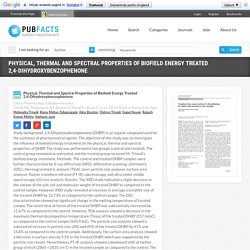
The objective of this study was to investigate the influence of biofield energy treatment on the physical, thermal and spectral properties of DHBP. The study was performed in two groups (control and treated). The control group remained as untreated, and the treated group received Mr. Modification of the Properties of Biofield Treated 2,6-Diaminopyridine. 2, 6-Diaminopyridine (2, 6-DAP) has extensive use in synthesis of pharmaceutical compounds.
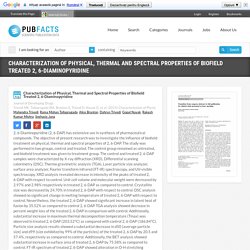
The objective of present research was to investigate the influence of biofield treatment on physical, thermal and spectral properties of 2, 6-DAP. The study was performed in two groups, control and treated. The control group remained as untreated, and biofield treatment was given to treatment group. The control and treated 2, 6-DAP samples were characterized by X-ray diffraction (XRD), Differential scanning calorimetry (DSC), Thermo gravimetric analysis (TGA), Laser particle size analyzer, surface area analyzer, Fourier transform infrared (FT-IR) spectroscopy, and UV-visible spectroscopy.
XRD analysis revealed decrease in intensity of the peaks of treated 2, 6-DAP with respect to control. Effect on Properties of 3-Nitroacetophenone. 3-Nitroacetophenone (3-NAP) is an organic compound used as an intermediate for the synthesis of pharmaceutical agents.

Critical Effect of Biofield Treatment on Methyl-2-Naphthyl Ether. Methyl-2-naphthyl ether (MNE) is an organic compound and used as the primary moiety for the synthesis of several antimicrobial and anti-inflammatory agents.

This study was attempted to evaluate the impact of biofield energy treatment on the physical, thermal, and spectroscopic properties of MNE. The study was carried out in two groups i.e., control and treated. The treated group was subjected to Mr. Assessment of Biofield Energy Treated Citrobacter Braakii. Biofield Energy Treatment Effect on Staphylococcus Aureus. Staphylococcus aureus (S. aureus) is the key organism for food poisoning due to massive production of heat stable exotoxins.
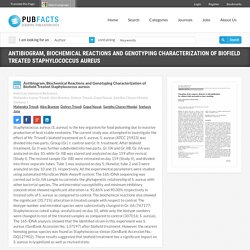
The current study was attempted to investigate the effect of Mr. Trivedi’s biofield treatment on S. aureus. An Alternative Treatment to Nocardia Contaminated Patients. Nocardiosis is a soil-borne aerobic infection caused by Nocardia species commonly affects the respiratory tract.
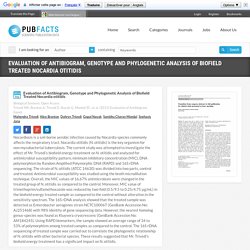
Nocardia otitidis (N. otitidis) is the key organism for non-mycobacterial tuberculosis. The current study was attempted to investigate the effect of Mr. An Alternative Strategy Against Strains of Staphylococcus Species. Antimicrobial resistance is a global health issue in the developing countries.

This study was carried out to evaluate the impact of Mr. Trivedi’s biofield energy treatment on multidrug resistant (MDR) clinical lab isolates (LSs) of Staphylococcus species viz. Examination of Enterobacter aerogenes after Biofield Energy Treatment. Enterobacter aerogenes (E. aerogenes) has been reported as the versatile opportunistic pathogen associated with the hospital infections worldwide.
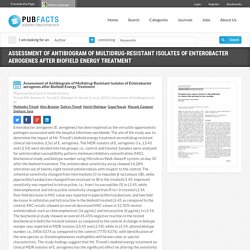
The aim of the study was to determine the impact of Mr. Trivedi’s biofield energy treatment on multidrug resistant clinical lab isolates (LSs) of E. aerogenes. The MDR isolates of E. aerogenes (i.e., LS 45 and LS 54) were divided into two groups, i.e., control and treated. Samples were analyzed for antimicrobial susceptibility pattern, minimum inhibitory concentration (MIC), biochemical study, and biotype number using MicroScan Walk-Away® system, on day 10 after the biofield treatment.
The antimicrobial sensitivity assay showed 14.28% alteration out of twenty eight tested antimicrobials with respect to the control. An Investigation on Klebsiella Pneumoniae after Biofield Treatment. Pathogenic isolates of Klebsiella pneumoniae (K. pneumoniae), particularly the extended-spectrum β-lactamase (ESBL) producing strains, are mostly associated with the failure of antibiotic therapy in nosocomial infections.

The present work was designed to evaluate the impact of Mr. Trivedi’s biofield energy treatment on phenotypic and genotypic characteristics of K. pneumoniae. The strain of K. pneumoniae bearing ATCC 15380 (American Type Culture Collection) was procured from the Bangalore Genei, in sealed pack and divided into control and treated groups.
Treated group was subjected to Mr. Trivedi’s biofield energy treatment and analyzed for the antimicrobial susceptibility, minimum inhibitory concentration (MIC), biochemical reactions, and biotyping using automated MicroScan Walk-Away® system. Characterization of Biofield Energy Treated p-Anisidine. The p-anisidine is widely used as chemical intermediate in the production of various dyes, pigments, and pharmaceuticals.

This study was aimed to evaluate the effect of biofield energy treatment on the physicochemical and spectroscopic properties of p-anisidine. The study was performed after dividing the sample in two groups; one was remained as untreated and another was subjected to Mr. Trivedi’s biofield energy treatment. Afterward, both the control and treated samples of p-anisidine were evaluated using X-ray diffraction (XRD), surface area analyzer, differential scanning calorimetry (DSC), thermogravimetric analysis-derivative thermogravimetry (TGA-DTG), Fourier transform infrared (FT-IR), and ultraviolet-visible (UV-Vis) spectroscopy.
The XRD analysis showed the increase in unit cell volume from 683.81 → 690.18 × 10-24 cm3 and crystallite size from 83.84→84.62 nm in the treated sample with respect to the control. Impact of Human Biofield Energy on Derivatives of Benzene. Benzene, toluene and p-xylene are derivatives of benzene, generally produced from crude petroleum and have numerous applications in industry. The aim of the present study was to evaluate the impact of biofield treatment on isotopic abundance of these benzene derivatives by gas chromatography-mass spectrometry (GC-MS). Benzene, toluene and p-xylene samples were divided into two parts: control and treatment. Control part was remained as untreated and treatment part was subjected to Mr.
Analyze Properties of p-Hydroxyacetophenone with Biofield Treatment. P-Hydroxyacetophenone (pHAP) is an aromatic ketone derivative that is mainly used in the manufacturing of various pharmaceuticals, flavours, fragrances, etc. In the present study, the impact of Mr. Trivedi’s biofield energy treatment was analysed on various properties of pHAP viz. crystallite size, surface area, melting temperature, thermal decomposition, and spectral properties. The pHAP sample was divided into two parts; one was kept as control sample while another part was named as treated sample. Evaluation of Biofield Treatment on Organic Compounds. In the present study, the influence of biofield treatment on physical and thermal properties of Casein Enzyme Hydrolysate (CEH) and Casein Yeast Peptone (CYP) were investigated. The control and treated samples were characterized by Fourier transform infrared (FT-IR) spectroscopy, differential scanning calorimetry (DSC), Thermo Gravimetric Analysis (TGA), particle size and surface area analysis.
The FTIR results revealed that biofield treatment has caused reduction of amide group (amide-I and amide-II) stretching vibration peak that is associated with strong intermolecular hydrogen bonding in treated CEH as compared to control. However, no significant changes were observed in FTIR spectrum of treated CYP. The TGA analysis of treated CEH showed a substantial improvement in thermal stability which was confirmed by increase in maximum thermal decomposition temperature (217°C) as compared to control (209°C).
Effect of Biofield Energy Treatment on Two Flavoring Agents. The present research work investigated the influence of bio-field treatment on two common flavoring agents used in food industries namely beef extract powder (BEP) and meat infusion powder (MIP). The treated powders were characterized by Fourier transform infrared spectroscopy (FT-IR), X-ray diffraction (XRD), particle size analysis, surface area analysis, differential scanning calorimetry (DSC), and thermogravimetric analysis (TGA). The FT-IR results showed disappearance of triglycerides peaks in both the treated powders as compared to control. XRD results corroborated the amorphous nature of both control and treated samples.
The BEP showed enhanced average particle size (d50) and d99 (size exhibited by 99% of powder particles) by 5.7% and 16.1%, respectively as compared to control. Contrarily, the MIP showed a decreased particle size (d50; 0.4% and d99; 18.1%) as compared to control. Significant Impact of Biofield Treatment on Shigella sonnei. Shigella sonnei (S. sonnei) is a non-motile, rod shape, clinically significant, Gram-negative bacterium. It is commonly associated with dysentery (shigellosis). Recently, resistance to third and fourth generation cephalosporins and fluoroquinolones has been reported in S. sonnei. Characterization of Biofield Energy Treated Neopentyl Glycol. Influence of Human Biofield Energy on Pharmaceutical Drugs.
Disulfiram is being used clinically as an aid in chronic alcoholism, while nicotinic acid is one of a B-complex vitamin that has cholesterol lowering activity. Influence of Human Biofield on Gluten Hydrolysate and Ipomoea Macroelements. An Alternative Approach to Cure Streptococcus group B Infected Patients. Antimicrobial Susceptibility Assay of Biofield treated Shigella Flexneri. Shigellosis is a major public health burden in India and its neighboring countries due to infection of Shigella species. Integrative Oncology. Study background: Glioblastoma (GBM) is the most common subtype of primary brain tumor in adults. The aim was to evaluate the impact of biofield treatment potential on human GBM and non-GBM brain cells using two time-lapse video microscopy technique. Methods: The human brain tumor, GBM cultured cells were divided into two groups viz. Evaluation of Biofield Energy Treatment on Enterobacter cloacae. Phenotype and Genotype Characteristics of Enterobacter aerogenes.
Enterobacter aerogenes (E. aerogenes) has been commonly described as a versatile opportunistic pathogen in hospital infections. Antibiogram Analysis of Pseudomonas Fluorescens after Biofield Treatment. Biofield therapies have been reported to improve the quality of life as compared to other energy medicine. The aim of the study was to evaluate the impact of Mr. Improve Stainless Steel Powder Properties after Biofield Treatment. Stainless steel (SS) has gained extensive attention due to its high corrosion resistance, low maintenance, familiar lustre, and superior mechanical properties. In SS, the mechanical properties are closely related with crystal structure, crystallite size, and lattice strain. Physical and Chemical Properties of Bronze Powder. Characterization of Barium Oxide and Zinc Sulfide. Characterization of Biofield Energy Treated Imidazole Derivatives. Analysis of Morganella morganii after Biofield Energy Treatment. Molecular Pharmaceutics & Organic Process Research.
An Experimental Study on Serratia marcescens. Properties of Salmonella paratyphi A after Biofield Therapy. Variation of Biofield Energy Treated Providencia rettgeri Properties. An Impact of Biofield Therapy on Properties of Para-Dichlorobenzene. An Investigation on the Properties of Myristic acid. Modification in Properties of Biofield Treated m-Toluic Acid. Mahendra Trivedi's Biofield Treatment Impact on Klebsiella pneumoniae. Characteristics of Klebsiella Oxytoca after Biofield Energy Treatment. Human Biofield Treated Disodium Hydrogen Orthophosphate and Sodium Nitrate. Antimycobacterial Susceptibility Potential. Biofield Treatment Effect on Ammonium Acetate and Ammonium Chloride. Characterization of Biofield Energy Treated Aluminium Carbide. Influence of Human Biofield Treatment on Thymol and Menthol.